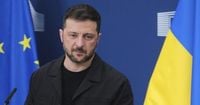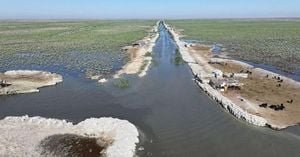In a dramatic escalation of the ongoing conflict, Ukrainian drones struck Russia’s Orenburg gas processing plant over the weekend of October 18 and 19, 2025, igniting a fire and forcing the world’s largest facility of its kind to halt intake of gas from neighboring Kazakhstan. The attack, confirmed by both Ukrainian and Kazakh authorities, marks a significant intensification in Kyiv’s campaign to target Russian energy infrastructure—a strategy aimed at disrupting Moscow’s war funding and fuel supplies.
According to Orenburg regional governor Yevgeny Solntsev, the drone strikes set a workshop ablaze and caused partial damage to the sprawling Gazprom-operated complex. The Orenburg plant, located near the Kazakh border, boasts an annual capacity of 45 billion cubic meters, handling gas condensate from Kazakhstan’s Karachaganak field as well as local Russian sources. Kazakhstan’s Energy Ministry reported that, following the attack, Gazprom notified them of an emergency that left the plant temporarily unable to process Kazakh gas. "Due to an emergency situation following a drone attack," the ministry said, the intake was suspended—though details on the extent of the damage and the timeline for resuming full operations remain unclear.
Ukraine’s General Staff, in a statement on Sunday, described a "large-scale fire" at the Orenburg plant and confirmed damage to one of its gas processing and purification units. This is the first time the facility has been reported hit since Ukraine began ramping up attacks on Russian refineries and energy nodes in August 2025. As reported by AP, Kyiv’s stated goal is to disrupt petrol supplies and deprive Moscow of the vital revenue that fuels its war effort. These strikes, Ukrainian officials argue, are a necessary counter to Russia’s continued bombardment of Ukraine’s own energy grid—a campaign that has left swathes of the country without power as winter approaches.
The Orenburg attack was part of a broader overnight exchange of drone strikes between the two adversaries. Ukrainian forces claimed to have shot down 40 of 62 Russian drones launched into Ukraine, while Russia’s Defense Ministry said it intercepted 45 Ukrainian drones, mostly over the Samara and Saratov regions. In the Dnipropetrovsk region, Russian drones damaged apartment blocks in the town of Shakhtarske, injuring 10 people. Meanwhile, Ukrainian authorities said a new Russian rocket-powered aerial bomb, the UMPB-5R, was used for the first time in an attack on Lozava, Kharkiv region, demonstrating Moscow’s evolving tactics for striking deeper into Ukrainian territory.
The drone war is just one front in a conflict that, more than three and a half years on, shows little sign of abating. As the strikes unfolded, high-level diplomatic maneuvering continued. Ukrainian President Volodymyr Zelenskyy, fresh from a visit to Washington D.C., made a pointed appeal to U.S. President Donald Trump to increase pressure on Russia’s Vladimir Putin. In an interview broadcast on NBC’s "Meet the Press," Zelenskyy drew a stark parallel, saying, "Putin is something similar, but more strong than Hamas. It’s [a] bigger war, and he is the second army in the world." Zelenskyy’s plea came after a meeting with Trump in which he sought U.S.-made Tomahawk missiles—long-range weapons that could allow Ukraine to hit targets deep inside Russia, potentially including Moscow.
Trump, however, was noncommittal. In a Fox News interview aired Sunday, he suggested that Ukraine may have to cede territory to Russia for peace, a notable shift from his earlier, more hawkish stance. "Well, he’s going to take something," Trump said, referring to Putin’s territorial ambitions. "They fought and he has a lot of property. He’s won certain property." Trump also expressed concern about depleting U.S. weapons stockpiles: "We need them for ourselves too. We can’t give all our weapons to Ukraine. We just can’t do that." These comments have left Kyiv’s hopes for Tomahawk deliveries in limbo, with Zelenskyy telling NBC, "It’s good that President Trump didn’t say ‘no,’" but acknowledging that he also "didn’t say ‘yes.’"
Trump’s reticence follows a recent call with Putin, during which, according to The Washington Post, the Russian leader demanded that Kyiv surrender full control of the Donetsk region as a condition for ending the war. Putin reportedly offered to forgo claims on parts of Zaporizhzhia and Kherson in exchange—a more restrained position than in prior negotiations, but still a non-starter for Ukraine, which retains control of the regional capitals in those territories.
While diplomatic efforts remain mired in stalemate, the war’s toll continues to mount. In addition to the Orenburg strike, Ukraine’s General Staff claimed a separate drone attack hit Russia’s Novokuibyshevsk oil refinery in the Samara region, sparking a blaze and damaging key refining units. Russian officials have not confirmed the extent of the damage. Meanwhile, Russian forces pressed on with attacks against Ukrainian energy infrastructure, causing widespread outages. In Chuhuiv, eastern Kharkiv, more than 10 strikes left nearly all districts without power, while in the northern city of Chernihiv, around 17,000 customers lost electricity after attacks on an energy facility in Koriukivka district.
The violence has not been confined to military targets. On October 17, a large explosion at the Avangard explosives factory in Sterlitamak, Russia, killed three women and injured five others. Local officials have denied speculation that the blast was caused by a drone attack, insisting it was an industrial accident. The plant, which produces weapons and ammunition for Russia’s military, continued operations despite the destruction of one building. In Russian-occupied Kherson, two people were killed in a Ukrainian drone strike on a temporary accommodation center for evacuees, according to the Russian-installed governor Vladimir Saldo.
Amid the chaos, some glimmers of stability have emerged. The International Atomic Energy Agency (IAEA) reported that repair work has begun on power lines to the Russian-held Zaporizhzhya nuclear power plant after a four-week outage—a crucial step for nuclear safety, as the plant’s reactors, though shut down, still require cooling powered by external electricity. Fighting had previously made repairs impossible, but both the IAEA and Russian officials now say conditions allow the work to proceed.
Internationally, support for Ukraine remains strong among European allies. British Prime Minister Keir Starmer, following a joint call with Zelenskyy and other European leaders, reiterated the UK’s "unwavering commitment to Ukraine in the face of Russian aggression," pledging continued humanitarian and military aid. Zelenskyy, for his part, emphasized the importance of unity and security for Ukraine and Europe, expressing gratitude for the ongoing support.
As winter looms and both sides intensify their campaigns against each other’s energy infrastructure, the conflict shows no sign of winding down. The Orenburg strike stands as a stark reminder of the war’s reach and the high stakes for all involved, underscoring the fragile balance between escalation and negotiation that now defines the struggle for Ukraine’s future.




